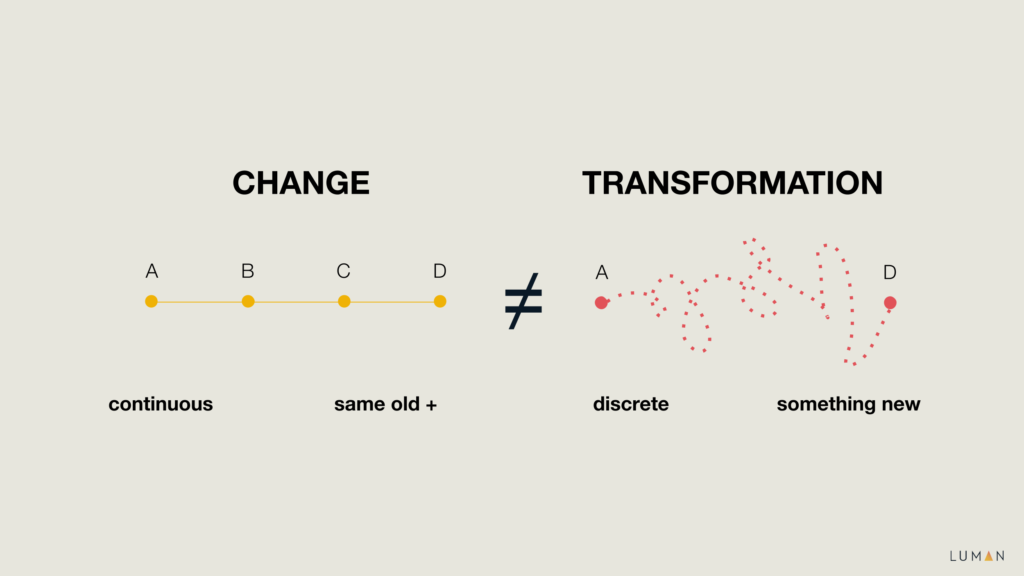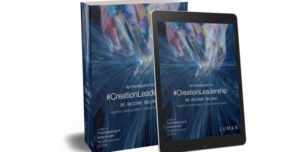Businesses large and small have traditionally struggled with organizational transformation.
This is not surprising.
There are two major factors contributing to these struggles:
- Organizations have mostly focused on the mechanics of transformation instead of the meaning
- Organizations have neglected the deep personal impact transformation has on people’s lives and the significant emotional investment that is required
As a result, transformation is whittled down to incremental change.
But incremental change will not suffice in a world of exponential developments in technology and culture.
Transformation does not equal change.
To understand all this, we first have to understand the distinction between change and transformation.
Change occurs all the time. As Alice said in her Wonderland experience “I knew who I was this morning, but I have changed several times since then.”
Change is a constant. Everything continues to evolve. Even the particles inside a diamond, supposedly lasting forever, rotate at the speed of 800m/s around the core. We are constantly exchanging electrons with the world around us. Our hearts (hopefully) keep pumping blood through our vessels, our cells die and new ones are being born in every moment. We go in and out of our homes and places of work, meet people, have conversations, learn new information, everything is in a constant state of flux.
Change is continuous and our experience of it contiguous.
We move from point A to point B, to C, to D, and so on (our steps, of course being defined merely arbitrarily, as we could break them down into infinitely tinier and tinier intervals — the neurotic insanity of analysis as such, but that is a different story).

Transformation is a whole different experience. While all transformations are massive changes, not all changes lead to transformation.
Transformation is discrete.
Transformation is akin to a quantum jump from point A directly to point D. It requires a death experience, a ceasing in point A, before we can appear anew in point D.
And that is the crux: Nobody likes to die.
“The most important thing to remember is this: to be ready at any moment to give up what you are for what you might become.” — W. E. B. Du Bois
But that is exactly what is required. To transform, we have to be willing to let go of what we know, who we are, and embark on a journey through the night, through Hades, through the underworld of darkness and confusion, before we are born again into a new being.
The caterpillar has to dissolve into mush before it can become the butterfly. The Phoenix has to be in ashes before rising from them.
Humans are pained with many paradoxes. One of them is that we like surprises and that we hate them at the same time. We want to know what we know, and yet we are still information seekers and want to learn more (information in the strict sense being only that, which we don’t know yet).
Noun thinking
We have also been taught to think in nouns. As we began to make sense of the world around us, our parents taught us words. First nouns, then adjectives, then verbs.
First, they established entities within the field of physical experience. Then they described them with more new words to indicate emotional context: “Good baby/dog”/ “Bad baby/dog”/ Like/Not Like — the level of consciousness we share with animals. Finally, we learned verbs and syntax to give rise to a (still linear) world of experience and interaction, and activate our mental cognition.
Within that, we have a bias to assume that nouns are stable: That dog will be dog. That house will be house. My neighborhood will be what it is. That “I” will be “I”, and “You” will be “You”.
Gradual change within that does not bother us too much. The cognitive dissonance is accepted and dealt with over time. Our dog will become a bit slower over time, our house will slowly look a bit more weathered, there is less and less snow on the ground in winter, “I” might have become a little plumper, “You” might have become a little more distant… Nearly unnoticeable.
We can adapt to gradual change just like the frog does not notice the water increasing in temperature until it is too late and he is boiled to death.

“I seem to be a verb” — Buckminster Fuller
Even though our nouns really seem to be verbs, as Buckminster Fuller suggested, we can pretend that the noun is still the same when change is gradual, and hold on to the illusion of a stable self.
With transformation this is a different story: When our dog dies. Or the roof on our house collapses. When suddenly there is no more snow in January or February in Chicago for the first time in recorded history, or when Bangladesh indeed has sunk into the ocean after that last big Tsunami. When “I” am looking in the mirror one day and don’t recognize or like the body in front of me. Or a once intimate “You” has suddenly become a stranger.
Transformation occurs as a massive shift. Something that was, is no longer the same thing. The noun has not just changed but has become a different thing, creating a whole new world of adjectives and verbs associated with it.
People might not like change, but they dread transformation.
Nobody is willing to give up who they are until the pain of the current state or the yearning for a future vision has become unbearable.
This goes for people, for teams, for organizations, and really for all systems. Until the wave reaches a breaking point, the system swells and sometimes even seems to go in reverse mode.
A human centered approach to Organizational Transformation
While it is easy to think about an organization as a thing, it is a system made up of humans. Ultimately, both end points of the value chain typically involve humans. Consumers and producers of value.
On the consumer side, companies have in recent years understood the importance of actually caring about the individual. The advent of hyper-customization, design thinking and especially empathy as a key component of design thinking, have shifted how large organizations treat their customers. The very beginning of a shift from product or service innovation to future lifestyle innovation can already be found in some forward thinking companies.
Some even more forward thinking companies are realizing that the same care and attention that they give to customers also makes sense on the employee side. In a world of free purpose agents, the employee has finally shifted into focus.
While there are still employees, as much as 94% of net job growth in the past decade was in the alternative work category according to Lawrence F. Katz of Harvard University and Alan B. Krueger of Princeton University.
“In the future there will be a very large ecosystem of For-Purpose Enterprises. With a whole community of Purpose Agents that can go shopping for purpose that they care about. ” — Thomas Thomison, HolacracyOne
With exponential technological development and the complete transformation of work, both in factories and offices, it is becoming clear that we now need something new:
We need humans who can innovate and collaborate at the speed of technology.
We now need organizational transformation programs that focus on building leadership capacities and cultural transformation first, thus preparing their workforce to face ever changing structures, markets and ecosystems of work.
And that is all about the human.
To create organizational transformation you need to start by creating conditions for your employees to be willing to transform.
For individuals to allow transformation, both psychological safety and emotional investment are essential requirements.
Psychological Safety
Google in a recent project looked for the keys to high-performing teams. After much searching they found that the team culture is more important to success than knowledge, skills and abilities. Among the most important factors contributing to higher levels of performance, they found Psychological Safety to be the most crucial.
Psychological Safety is the degree to which an individual feels comfortable taking positive interpersonal risks (such as trying something new). Academia has recently become even more aware of the importance of psychological safety and its effect on human development and how humans learn and grow.
When individuals feel psychologically safe, they are willing to take on more risk, and they can exercise their agency and engage in experiences and interactions throughout life and work. When individuals feel safe, they are willing to face the unknown. Instead of terrifying, the unknown then becomes exciting. When they feel safe and consider events as benign, they interpret even boundary violations as humorous.
Emotional Investment and Meaning
Transformation requires a significant emotional investment. Emotional investment comes from meaning. Both personal meaning and meaning that is tied to a larger picture.
That is where purpose comes in.
Purpose can provide the necessary emotional connection to make transformation acceptable.
Increasingly, both on the consumer as well as the employee side, purpose is becoming non-negotiable. If your company’s purpose is to make money, you are missing the point and confusing measurement with the goal of your activities. Profit is a means of measuring the efficiency of your business, not the efficacy. If the purpose of your business is to get customers, your purpose is too small.
Purpose today has to be something your customers and employees equally care about. Purpose is about the why beyond your current business model (which is how you currently might fulfill your purpose):
- An organizational purpose that addresses something in the world that your employees care about is the first step in activating emotional investment for your employees.
- Second, their role’s purpose has to be clear and tied to how you are ultimately fulfilling the bigger purpose.
- Third, their personal purpose has to be connected to their role and the organization as a whole.
Dan Pontefract in his book The Purpose Effect describes this space in the middle of organizational, role and personal purpose as the “sweet spot”.
Hence, if you wish to create transformation in your organization, the logical part to start with is purpose.
Becoming clear about your purpose will provide you with the foundation for reaching a future state, even if you are not sure how to get there yet.
A Roadmap for Organizational Transformation
This is why, when supporting organizations with transforming toward the future of work, we start with purpose. We then focus on engaging and training people in capacities required to thrive in volatile and uncertain environments, have them determine future processes, and what it will take to build platforms and systems to support the new state. Finally, we look at propagation of the new culture throughout the organization.
So, take a moment to think of yourself, your team and the people in your organization: How could you best support the connection to purpose to prepare them for the transformations ahead?





